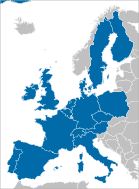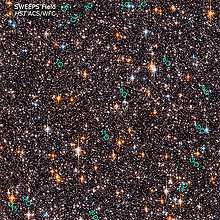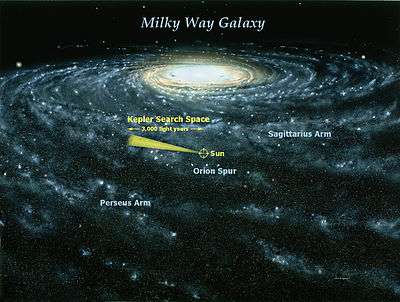Swiss 1.2-metre Leonhard Euler Telescope
Leonhard Euler Telescope, or the Swiss EULER Telescope, is a national, fully automatic 1.2-metre (47 in) reflecting telescope, built and operated by the Geneva Observatory. It is located at an altitude of 2,375 m (7,792 ft) at ESO's La Silla Observatory site in the Chilean Norte Chico region, about 460 kilometers north of Santiago de Chile. The telescope, which saw its first light on 12 April 1998, is named after Swiss mathematician Leonhard Paul Euler.[1][2]
 The enclosure of the Leonhard Euler Telescope with the higher situated New Technology Telescope in the background | |
| Alternative names | Swiss 1.2-m Leonhard Euler Telescope |
|---|---|
| Named after | Leonhard Euler |
| Part of | La Silla Observatory |
| Location(s) | Norte Chico |
| Coordinates | 29°15′34″S 70°43′59″W |
| Organization | Geneva Observatory |
| First light | 12 April 1998 |
| Telescope style | reflecting telescope |
| Diameter | 1.2 m (3 ft 11 in) |
 Location of Swiss 1.2-metre Leonhard Euler Telescope | |
The Euler telescope uses the CORALIE instrument to search for exoplanets. In addition, the telescope uses the multi-purpose EulerCam (ecam), a high precision photometry instrument, and a smaller, piggyback mounted telescope, called "Pisco".[2] Its first discovery was a planet in orbit around Gliese 86, determined to be a hot Jupiter with an orbital period of only 15.8 earth days and about four times the mass of Jupiter.[3] Since then, many other exoplanets have been discovered or examined in follow-up observations.
Together with the Mercator Telescope, Euler was part of the Southern Sky extrasolar Planet search Programme, which has discovered numerous extrasolar planets.[4] It has also been frequently employed for follow-up characterization to determine the mass of exoplanets discovered by the Wide Angle Search for Planets, SuperWASP.[5]
Instruments
The CORALIE spectrograph is an echelle type spectrograph used for astronomy and was commissioned at the Euler Telescope in April 1998. The instrument performs doppler spectroscopy, that is it measures the Doppler effect on a star's electromagnetic spectrum caused by the gravitational tug of an exoplanet orbiting around it.[6][7] The spectrograph participates in the Southern Sky extrasolar Planet search Programme.
Doppler spectroscopy, also known as "radial velocity" or "wobble" method, is an indirect detection method as it only observes the star's spectrum and not the planet itself. It differs from the transit method used by the space-based Kepler mission and ground-based SuperWASP and Next-Generation Transit Survey and can therefore be complementary to their observations. This is because the size of an exoplanet can be estimated using the transit method, while Doppler spectroscopy is used to estimate its mass. By combining the measured size and mass from both methods, it can be determined whether the observed exoplanet is gaseous or rocky.
The ELODIE spectrograph was a device similar to CORALIE[8]
Characteristics
The resolution of CORALIE is fixed at R = 50,000 with a 3 pixel sampling. The detector CCD is 2k X 2k with a 15 micrometer pixel size.
Discovered exoplanets
Five planetary object have been discovered using CORALIE along with several confirmations of discoveries by other programs.
| Planet | Announced in | Refs |
|---|---|---|
| Gliese 86 b | 1998 | [6] |
| HD 75289b | 1999 | [9] |
| HD 130322 b | 1999 | [9] |
| HD 192263b | 1999 | [10][11] |
| GJ 3021b | 2000 | [12] |
Gallery
 The 1.2-meter Leonhard Euler Telescope
The 1.2-meter Leonhard Euler Telescope Euler Telescope with the ESO 3.6-meter in the background
Euler Telescope with the ESO 3.6-meter in the background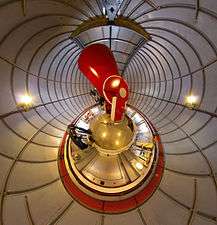 A fisheye view of the Euler Telescope
A fisheye view of the Euler Telescope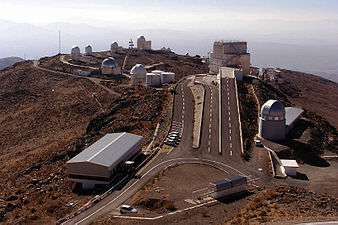
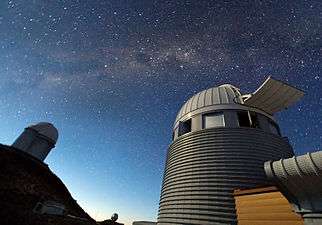 Euler and ESO 3.6-meter are both exoplanet hunters at La Silla
Euler and ESO 3.6-meter are both exoplanet hunters at La Silla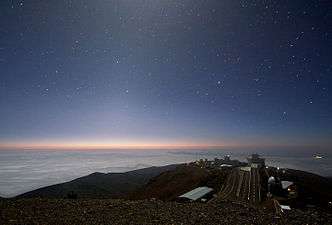 Moonlight and Zodiacal Light Over La Silla Observatory
Moonlight and Zodiacal Light Over La Silla Observatory Sunset at ESO's La Silla observatory in Chile
Sunset at ESO's La Silla observatory in Chile Fantastic Mr Fox
Fantastic Mr Fox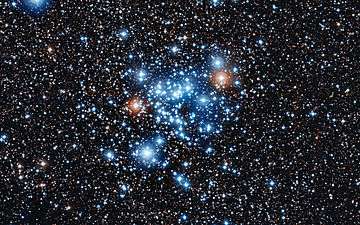 Star cluster NGC 3766
Star cluster NGC 3766
Video
See also
References
- "Swiss 1.2-metre Leonhard Euler Telescope". ESO. Retrieved 10 September 2015.
- "EULER". Exoplanets. Switzerland: Université de Genève. Retrieved 10 September 2015.
- Queloz, D.; Mayor, M.; Weber, L.; Blecha, A.; et al. (1999). "A planet orbiting the star Gliese 86". arXiv:astro-ph/9910223.
- "Southern Sky extrasolar Planet search Programme". unige.ch.
- Queloz, D.; Anderson, D. R.; Collier Cameron, A.; Gillon, M.; et al. (2010). "WASP-8b: a retrograde transiting planet in a multiple system". Astronomy and Astrophysics. 517: L1. arXiv:1006.5089. Bibcode:2010A&A...517L...1Q. doi:10.1051/0004-6361/201014768.
- Queloz, D.; Mayor, M.; Weber, L.; Blécha, A.; et al. (2000). "The CORALIE survey for southern extra-solar planets. I. A planet orbiting the star Gliese 86". Astronomy and Astrophysics. 354: 99–102. Bibcode:2000A&A...354...99Q.
- ESO publication, D. Queloz and M. Mayor, From CORALIE to HARPS, September 2001
- "Extrasolar Planet Search Programme at Haute-Provence Observatory". Observatory of Geneva. Retrieved 17 August 2015.
- Udry; Mayor, M.; Naef, D.; Pepe, F.; et al. (2000). "The CORALIE survey for southern extra-solar planets II. The short-period planetary companions to HD 75289 and HD 130322". Astronomy and Astrophysics. 356: 590–598. Bibcode:2000A&A...356..590U.
- Santos, N.; Udry, S.; Mayor, M.; Naef, D.; et al. (2003). "The CORALIE survey for southern extra-solar planets XI. The return of the giant planet orbiting HD192263". Astronomy and Astrophysics. 406 (1): 373–381. arXiv:astro-ph/0305434. Bibcode:2003A&A...406..373S. doi:10.1051/0004-6361:20030776.
- Santos, N.; Mayor, M.; Naef, D.; Pepe, F.; et al. (2000). "The CORALIE survey for southern extra-solar planets III. A giant planet in orbit around HD 192263". Astronomy and Astrophysics. 356: 599–602. Bibcode:2000A&A...356..599S.
- Naef, D.; Mayor, M.; Pepe, F.; Queloz, D.; et al. (2001). "The CORALIE survey for southern extrasolar planets V: 3 new extrasolar planets". Astronomy and Astrophysics. 375 (1): 205–218. arXiv:astro-ph/0106255. Bibcode:2001A&A...375..205N. doi:10.1051/0004-6361:20010841.
External links
| Wikimedia Commons has media related to Leonhard Euler Telescope. |
